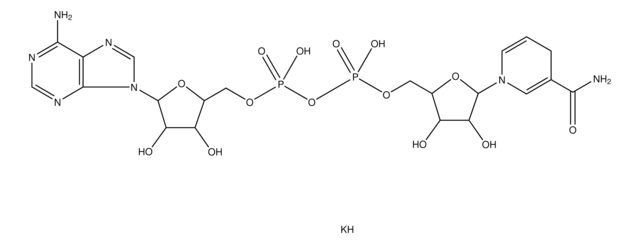N6785
β-Nicotinamide adenine dinucleotide, reduced disodium salt
~98%, pkg of 10 mg (per vial)
Synonym(s):
β-DPNH, β-NADH, Coenzyme I reduced disodium salt, Diphosphopyridine nucleotide reduced disodium salt
About This Item
Recommended Products
Assay
~98%
Quality Level
form
powder
packaging
pkg of 10 mg (per vial)
SMILES string
[Na+].[Na+].NC(=O)C1=CN(C=CC1)[C@H]2O[C@@H](COP([O-])(=O)OP([O-])(=O)OC[C@H]3O[C@H]([C@H](O)[C@@H]3O)n4cnc5c(N)ncnc45)[C@H](O)[C@@H]2O
InChI
1S/C21H29N7O14P2.2Na/c22-17-12-19(25-7-24-17)28(8-26-12)21-16(32)14(30)11(41-21)6-39-44(36,37)42-43(34,35)38-5-10-13(29)15(31)20(40-10)27-3-1-2-9(4-27)18(23)33;;/h1,3-4,7-8,10-11,13-16,20-21,29-32H,2,5-6H2,(H2,23,33)(H,34,35)(H,36,37)(H2,22,24,25);;/q;2*+1/p-2/t10-,11+,13-,14+,15-,16+,20-,21+;;/m0../s1
InChI key
QRGNQKGQENGQSE-QUWMEQBESA-L
Looking for similar products? Visit Product Comparison Guide
Application
Biochem/physiol Actions
Reconstitution
Other Notes
Choose from one of the most recent versions:
Certificates of Analysis (COA)
Don't see the Right Version?
If you require a particular version, you can look up a specific certificate by the Lot or Batch number.
Already Own This Product?
Find documentation for the products that you have recently purchased in the Document Library.
Customers Also Viewed
Our team of scientists has experience in all areas of research including Life Science, Material Science, Chemical Synthesis, Chromatography, Analytical and many others.
Contact Technical Service




